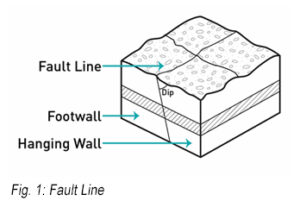EARTHQUAKE RISK ASSESSMENT: CAN WE PREDICT THE NEXT ‘BIG ONE’?
By David L. Teasdale P.E., Haag Principal Engineer
An earthquake is little more than a release of energy when two sides of a fault line slip relative to each other. A fault is a break in the rock crust, generally miles below the surface, and faults were created long ago as tectonic plates drifted to their current positions. 
Therefore, all parts of the United States have fault lines, and any part of the United States has the potential for an earthquake as the tectonic plates continue moving. As might be expected with any moving, flexible plate, parts of that plate move differently, and the plate surface deforms. (Recall from high school geology that the rise of mountains and other land features is attributed to this deformation.) Continued plate movement and localized surface deformations cause different sides of a fault to bind against each other, and binding builds up internal strains in the rock. Built-up energy may eventually be released through slipping along a fault line, and we feel that slip as an earthquake.
While every part of the United States has fault lines, not every fault line is actively moving and binding, and those that are active are not storing energy at the same rate or in the same kind of rock geology. Therefore, the risk of an earthquake varies by region for many different reasons, and risk assessment is hampered by the sheer size of the moving parts, the variability of materials, and our understanding of the process. Presently, risk assessment is based on the size and frequency of past earthquakes. California is on the leading edge of North American plate, and faults are more active, as it collides with the Pacific Plate to the west and rides up over the “subduction zone”. (Refer to http://www.sanandreasfault.org/Tectonics.html for further explanation.)
It is presently believed that periodic release of energy through smaller earthquakes helps prevent a larger earthquake, but discovery of new faults and awakening of dormant faults is ongoing with time. No scientist knows precisely what might happen next, and consideration of the unknown always fuels discussion of the inevitable “big one”. 
Study of California geology and past earthquakes leads seismologists to consider the maximum credible event around a magnitude 8.0. Magnitudes are logarithmic, and each magnitude level is about 32 times greater than the previous one (M5 is32 times greater than M4).
Therefore, the maximum credible event for California is more than 1,000 times greater than the Northridge earthquake in 1994 (M6.7). Buildings of different age, construction materials, and design behave differently when shaken, but good detailing of connections goes a long way toward safely resisting earthquake shaking. In the United States, one can generally assume that most buildings will perform well with little damage at magnitudes below 5.0, even when they are not constructed using earthquake standards, but damage is influenced by magnitude, duration of shaking, distance from the involved fault, depth of the earthquake focus, frequency content, and other factors.
Earthquakes in the Midwest and other regions of the United States are much less frequent, but areas like the New Madrid fault, the Wasatch Fault, and the Middleton Place – Summerville Seismic Zone (Missouri, Utah, and South Carolina, respectively) have all experienced extraordinary shaking events in their histories similar to a maximum credible event in California.
The frequency of these events is around once every 500 years, on average, so residents of these areas may not feel the urgency about earthquakes that Californians might feel. Residents of central Oklahoma routinely experience short shaking events up to about M3.5 without significant alarm. Curiously, building codes handle the risk of infrequent strong events by including seismic requirements in design but reducing the force levels. These measures will save lives in a surprise shake of moderate proportions, but they will not likely make much difference if these areas experience a large event. Therefore, much of the United States is effectively “playing the averages” when it comes to earthquakes, but averages over geologic time are just that, averages. The next one could be in 1,000 years or 100 years.

Much effort has been made to predict earthquakes, and these efforts usually involve measuring fault movements with the hopes of understanding when they are apt to slip. Where the strain energy theory of earthquakes is prevalent, it is often thought that small tremors can presage a larger event, and seismologists have seen small excitations in their studies that might someday offer a reliable advance warning of several minutes or more.
Predicting how large that event might be, however, is still well beyond current knowledge. Given the difficulties in evaluating earthquake initiation where faults can be studied over time, one can see the difficulty of evaluating fault activity in new areas like those where hydraulic fracking is underway, for example. Seismologists can postulate theories as to how water injection might lubricate faults and cause movement, but moving the earth is not as easy as all that. Further study of a region along with consideration of other factors like depth, procedures, and time lapse since the last injection often lead geologists to discount the effects of human activity. In the meantime, the rest of us can sleep better believing that a historically inactive region likely will not have a lot of strain energy stored in its faults, and small tremors will reduce that energy even if they result from human activity. It’s as good a theory as any at this time.

David Teasdale, P.E., Haag Engineer
David Teasdale specializes in Structural Evaluations, Earthborne and Airborne Vibrations, Geotechnical Evaluations, General Civil Engineering, & Wind Engineering and Related Storm Effects. He is the primary author and presenter of a Haag seminar course on earthquake damage assessment titled “California Earthquake Adjuster Accreditation“. See his profile here.

